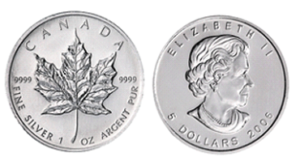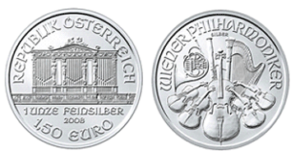Often relegated to the status of “poor man’s gold,” silver is anything but that.
Silver is one of the seven metals of antiquity, which also include gold, copper, tin, lead, iron, and mercury.
But silver shares many of gold’s properties as well, and for that reason, it has intrinsic value.
As global debt levels continue to swell to all-time records, silver is set to cement its place in history all over again.
And owning silver coins is a first-line defensive strategy everyone needs to arm themselves with.
Living Up to the Silver Standard
As far back as 4,000 years ago, ancient Greeks used silver ingots and coins in trade.
Few people realize that in past centuries, there existed not only a gold standard, but also a silver standard.
Romans referred to silver traders as “argentarius,” and the French still use the word “argent” (silver) to mean money.
By the 16th century, an international silver standard had developed which lasted until as late as 1935 in China and Hong Kong.
In the United States, a silver standard was established in 1785 based on the Spanish milled dollar. The 1792 Mint and Coinage Act made it law, and all U.S. currency had to be backed by silver.
But fiat money has since replaced precious metals, to nearly everyone’s detriment. History has shown us repeatedly that even monetary systems ebb and flow.
And given the advanced mammoth credit cycle we’re in, silver remains a top choice for investors.
Long List of Benefits and Super Undervalued: No Better Time to Buy
Silver is an ideal form of money because it’s a precious metal like gold and shares many of its benefits.
Silver is indestructible, has no counterparty risk, is a store of value, is private, can’t be hacked, and retains its value. In addition, the metal is fungible, in relatively limited supply, highly divisible, and universally recognized and desired.
One aspect where silver differs from gold is its value to weight ratio. Since silver is much cheaper than gold per ounce, it’s been easier to use for smaller transactions.
The gold to silver ratio is currently near 85, which is historically very high, suggesting silver is especially cheap compared to gold. In fact, the ratio is now higher than it was even during the 2008 financial crisis.
Given silver’s extreme undervalued status, it would be hard to find a better time to add silver coins to your financial arsenal.
So let’s take a look at my three favorites…
A Winning Trifecta
Like gold, you’ll want to stick with government-mint produced bullion coins.
These are easily recognized by market participants virtually everywhere. They also have the benefit of standard size, silver content, and purity. And they also benefit from continuity, with the same coin having been in production for decades.
(SIDENOTE: Keep in mind that collectible [also known as numismatic] coins are a whole other market, often with sizeable premiums to the silver content. That means you could be paying a lot of money beyond the value of the silver. That doesn’t mean it’s not worthwhile – only that you really have to know what you’re doing. I don’t recommend collectible coins unless it’s to investors who are extremely well-versed in this market.)
The following are all equally good options, but it makes sense to buy coins that are either issued by your own government mint or are commonly available where you live.
- The American Eagle Silver One-Ounce Ccoin: It has been produced by the U.S. Mint since 1986 and is one of the Mint’s all-time best-sellers, with over 500 million sold. Its weight, content, and purity are all government guaranteed. A full-length figure of Liberty appears on the obverse, and an eagle with a shield appear on the reverse. It contains one troy ounce of 0.999 fine silver and has a face value of 1 U.S. dollar.

- The Canadian Maple Leaf Silver One-Ounce Coin: It’s produced by the Royal Canadian Mint and is one of the world’s most recognizable silver coins. What’s more, it’s set the standard for purity, weighing in at 0.9999 fine silver, whereas others reach only 0.999 fineness. It sports a face value of $5, the highest of all high-volume minted silver bullion coins. All of these features combine for one of the world’s most popular silver bullion coins. Naturally, on one side of the coin is a large detailed maple leaf, and on the reverse is the profile of Queen Elizabeth II.

- The Austrian Philharmonic Silver One-Ounce Coin: It’s produced by the Austrian Mint and celebrates the Vienna Philharmonic Orchestra, depicting an assortment of musical instruments, including a string bass, cellos, violins, a harp, a Viennese horn, and a bassoon. The obverse shows the great organ of the Musikverein concert hall in Vienna. The Austrian Mint has produced tens of millions of these coins, which come at 0.999 purity and sport a face value of 1.50 euros.
Before I finish, I’d like to look a bit into premiums.
Consider that premiums on silver currently run at about 16%. While this isn’t cheap, there are several reasons why. Given that the value of an ounce of silver is relatively low, the mint’s production costs are proportionately high. Government mints add a surcharge for production, seigniorage, and profit. Coin dealers will add their own fees associated with buying, selling, inventorying, and shipping.
Of course, supply and demand always factor into silver premiums as well. But consider that during the 2008 financial crisis, some dealers were selling silver coins at astronomical levels of 75% above spot price. So economics and geopolitics also have considerable influence on premiums. I suspect today’s levels around 16% will once again look like extreme bargains within the next few years.
Remember to always buy from a reputable dealer and look for competitive premiums. If you’re going to buy an “eternal asset” with major upside potential, you’re going to want the best. After all, you may own it for a long time.
— Peter Krauth
Source: Money Morning



